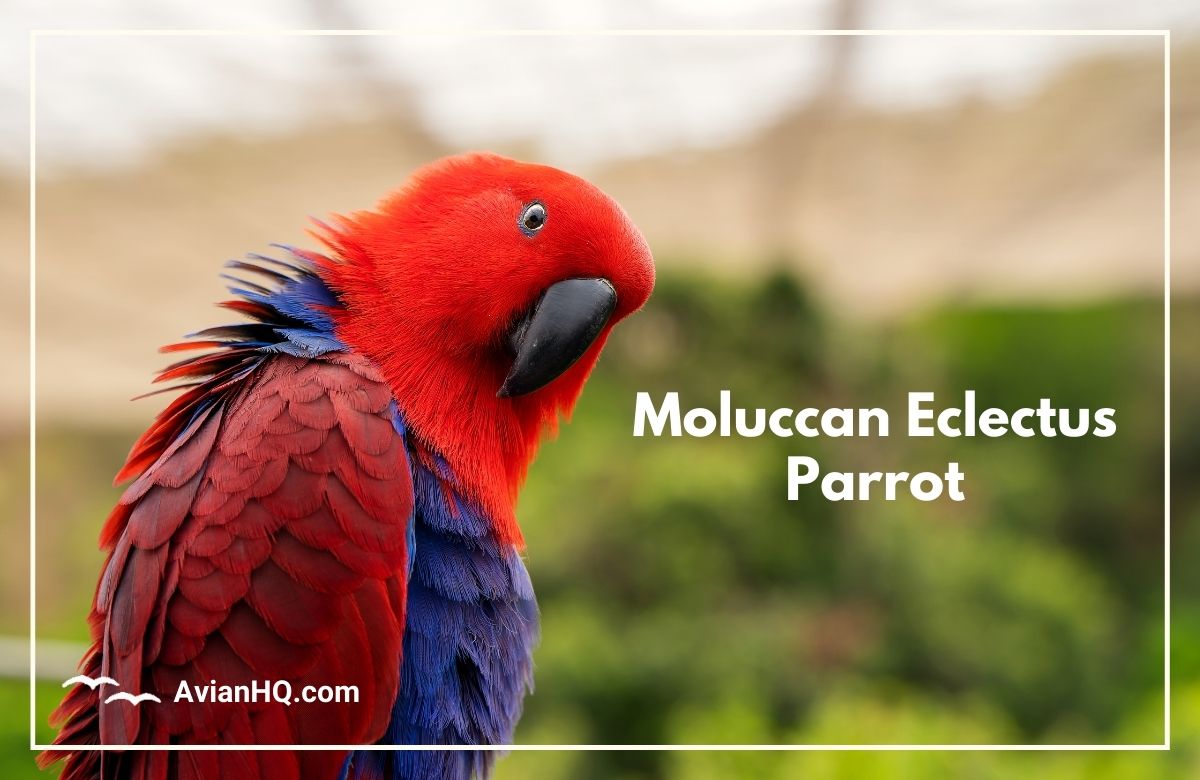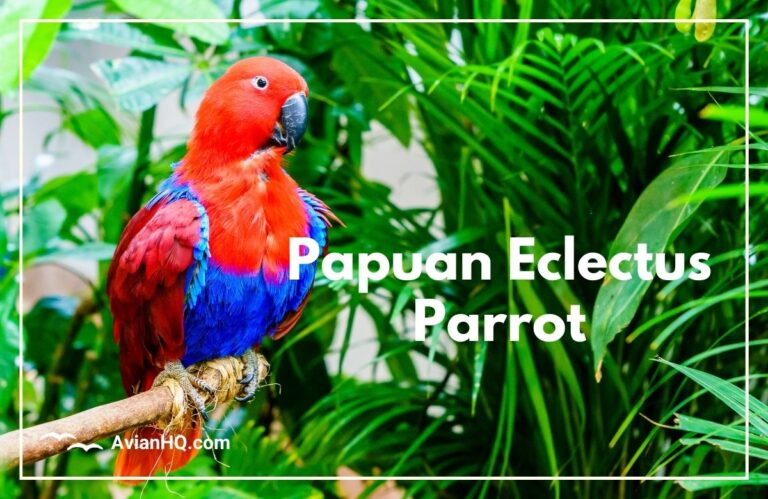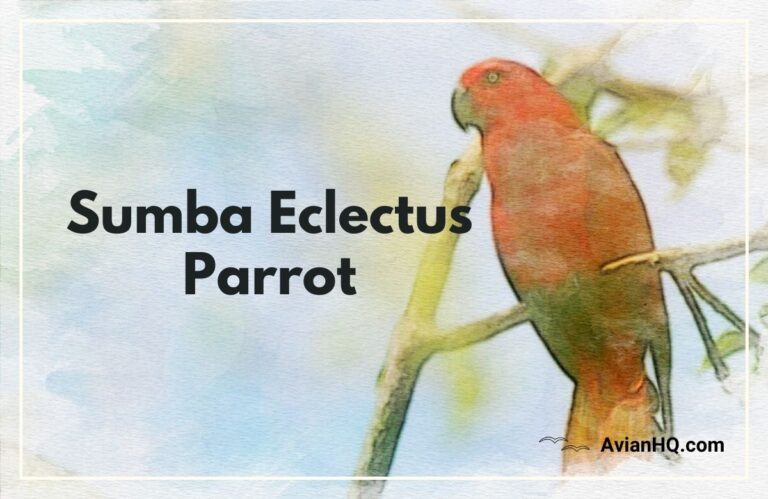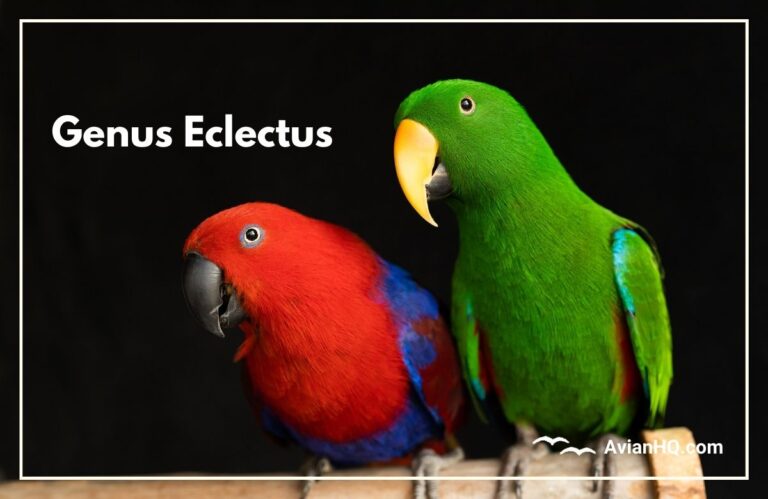Moluccan Eclectus Parrot (Eclectus roratus)
The beautifully colored and intelligent Moluccan Eclectus Parrot is a fascinating bird that makes a delightful pet for the right owner. This medium-sized parrot is native to Indonesia, Papua New Guinea, and surrounding islands, where it inhabits tropical forests and woodlands.
The most striking feature of the Moluccan Eclectus is the extreme difference in plumage between males and females. Males sport vibrant emerald green feathers, while females dazzle in bright red and purple. When you first see these birds, you might think you’re looking at two completely different species!
In this article, we’ll explore everything you need to know about these magnificent parrots, including their natural history, behavior, care requirements, and conservation status. Whether you’re an ornithology buff or considering adding one of these beauties to your family, you’ll learn some captivating facts about this eye-catching bird.
History and Taxonomy of the Eclectus Parrot
The Moluccan Eclectus Parrot was first described scientifically in 1776 by German naturalist Philipp Ludwig Statius Müller. He gave the bird the binomial name Psittacus roratus, with the genus later changed to Eclectus.
The name “Eclectus” is derived from a Greek word meaning “chosen” or “select,” referring to the parrot’s brightly colored plumage. The species name “roratus” comes from a combination of Proto-Indo-European and Sanskrit words meaning “moisture” or “humidity,” describing it’s rainforest habitat.
Today, there are 9 recognized subspecies of the Eclectus Parrot:
- Eclectus roratus roratus – native to Indonesia and Maluku Islands
- Eclectus roratus vosmaeri – native to northern Maluku Islands
- Eclectus roratus cornelia – native to Sumba Island, Indonesia
- Eclectus roratus polychloros – native to the Tanimbar Islands
- Eclectus roratus solomonensis – native to the Solomon Islands
- Eclectus roratus biaki – native to Biak Island, Indonesia
- Eclectus roratus riedeli – native to New Guinea
- Eclectus roratus aruensis – native to the Aru Islands, Indonesia
- Eclectus roratus macgillivrayi – native to Cape York Peninsula, Australia
The subspecies vary somewhat in size and precise plumage coloration. But they all share the same beautiful dichromatic plumage that makes the Eclectus Parrot so visually striking.
Now let’s look at the physical appearance and markings of this colorful bird.
Moluccan Eclectus Parrot Physical Appearance
The Moluccan Eclectus is a medium-sized, stocky parrot measuring about 35 cm (13.8 inches) long with a wingspan of 30-36 cm (12-14 inches). It weighs between 450-600 g (1-1.3 lbs).
As mentioned, the most notable feature of this species is the extreme difference in coloration between males and females, a phenomenon known as sexual dichromatism.
Male Eclectus Parrots are primarily bright emerald green on their body, wings, tail, and helmet (top of head). They have vivid blue primaries on their wings and wingtips. The undersides of their wings and sides of their belly are a deep scarlet red. Their short square tails are green in the center, tipped with blue edges. Their eyes are orange and their upper beak is orange-yellow, while the lower beak is black.
Female Eclectus Parrots are mostly vibrant red and purple. Their heads, necks, backs, breast, and tail feathers are bright red, with some darker red-brown on the back and wings. It’s lower breast and belly have a broad band of violet-blue, along with blue on the bend of the wings. Their wingtips display a mix of mauve-blue and their tails are red tipped with orange. Their eyes are rimmed with blue and their beaks are all black.
The striking dichromatism of the males and females makes the Moluccan Eclectus Parrot truly one of a kind in the parrot world.
Habitat and Distribution of the Moluccan Eclectus
The Moluccan Eclectus Parrot is native to Indonesia, Papua New Guinea, the Solomon Islands, and northeastern Australia. It’s natural habitats are tropical rainforests, woodlands, mangroves, and freshwater swamps.
Specifically, it’s range includes:
- Indonesia – Maluku Islands, Aru Islands, Obi Islands, Sumba Island, Seram Island, Buru Island
- Papua New Guinea – mainland and surrounding islands
- Solomon Islands – including Guadalcanal, Malaita, Isabel, and San Cristobal
- Australia – Cape York Peninsula in northern Queensland
The Eclectus resides in the mid to upper canopy of rainforests, at elevations up to 1,200 m (3,900 ft). It is also found in eucalyptus woodlands, melaleuca forests, monsoon forests, and wooded habitats along the coast.
Some island populations with restricted ranges, like on Obi Island, are at higher risk and have declined due to trapping for the pet trade. But overall the Moluccan Eclectus remains widespread throughout it’s native range.
Diet and Feeding Habits
In the wild, the Moluccan Eclectus is herbivorous and frugivorous, feeding primarily on fruits, nuts, seeds, buds, and blossoms. Their specialized diet includes:
- Fruits – Figs, papaya, pomegranate, mangos, citrus fruits
- Nuts and seeds – almonds, walnuts, cashews, pine nuts
- Flower buds and nectar
- Leaf buds
- Some small insects and larvae
The Eclectus uses it’s strong curved bill to open hard nuts and seeds. It feeds mainly in the rainforest canopy, foraging for ripe fruits and seeds.
During breeding season, the male Eclectus flies up to 12 miles (20 km) daily to find food, then returns to regurgitate for the female and chick. The female remains in the nest hollow, relying on the male for nourishment.
The Eclectus has an unusually adaptable digestive system that can process high-fiber foods. It’s elongated gastrointestinal tract even allows it to eat mildly toxic foods other birds cannot.
Breeding and Reproduction
The Moluccan Eclectus nests in natural hollows and cavities in tall rainforest trees, usually at great heights of 65-130 ft (20-40 m).
Females are very possessive of their nest sites and will vigorously defend them from other females. Once choosing a nesting tree, the female remains in the hollow for up to 11 months of the year, rarely leaving.
Courtship and Mating
The Eclectus is polygamous, with each female mating with multiple male partners. Up to 5 males may regularly feed and interact with a single female. The males compete to mate by displaying bright plumage and regurgitating food offerings.
Nesting
The female alone prepares the nest inside the hollow, using bits of wood. She lays 2 glossy white eggs, which she incubates for 28-30 days until hatching.
Chicks
The chicks hatch altricial (helpless) and fledge at around 11 weeks old. Both parents regurgitate food for the chicks.
Maturity
Moluccan Eclectus reach sexual maturity between 2-4 years old. Their average lifespan in the wild is estimated around 30 years.
Behavior and Ecology
The Moluccan Eclectus exhibits some interesting behaviors and adaptations:
Social
- Lives in small flocks of up to 30 birds
- Forms monogamous pairs during breeding season
- Vocalizes with loud squawking calls and chuckling sounds
Feeding
- Forages for fruit, nuts, and seeds high in the rainforest canopy
- Uses strong bill to crack hard nuts and fruits
- Males fly up to 20 km to find food for female and chicks
Roosting
- Rests in large communal roosts at night for safety
- Up to 80 birds may gather at a single roost tree
Seasonal
- Does not migrate; remains in rainforests year-round
- Nesting season peaks from August-January
Defense
- Color dimorphism helps camouflage male and female roles
- Toxic foods in diet may provide some protection from predators
Overall, the Eclectus is well-adapted to it’s arboreal rainforest niche. However, habitat destruction poses the biggest threat to it’s future.
Conservation Status
The Moluccan Eclectus is evaluated as Least Concern on the IUCN Red List of Threatened Species. It’s total population is estimated at 7,300 to 51,000 mature individuals.
However, it’s numbers are decreasing due to:
- Habitat loss – Deforestation for logging and agriculture reduces nesting sites and food sources.
- Hunting – Illegal trapping for the pet trade removes many birds from the wild annually.
- Island populations – Small isolated populations on islands are most vulnerable to extinction. The Obi Island subspecies is endangered.
Conservation actions needed:
- Preserve rainforest habitats in it’s native range
- Protect nesting trees and roosting sites
- Enforce trapping quotas and trade regulations
- Captive breeding programs to supplement wild populations
With proper habitat conservation and protections, this uniquely beautiful parrot can continue to thrive in it’s island home. The brilliance of the Moluccan Eclectus belongs free in the wild.
Cultural Significance
The Moluccan Eclectus holds a special place in the culture of native tribes in New Guinea and the Solomon Islands.
- Bright red and green feathers are prized for ceremonial costumes, headdresses, and decorations.
- Tail feathers are used in rituals and tribal dances.
- Believed to convey magic powers and symbolize the union between man and nature.
- Regarded as guardian spirits that protect villages. Killing them was taboo.
- Depicted in tribal mythology and folklore.
- Live birds kept as status symbols by chieftains.
Today, the Eclectus remains an icon of the tropical forests where it naturally occurs. It’s brilliant plumage will likely continue to captivate human cultures for centuries to come.
The Eclectus Parrot has also become a popular aviary bird, which we’ll explore next.
Eclectus Parrots as Pets
The beautiful and intelligent Eclectus Parrot has become a popular pet bird around the world. Some key facts about keeping Eclectus Parrots:
- Lifespan – Up to 30-40 years with proper care
- Size – Require large enclosures at least 2 ft x 3 ft x 4 ft (60 cm x 90 cm x 120 cm)
- Diet – Need variety of fresh fruits, veggies, high-fiber pellets
- Enrichment – Need large cages, play stands, toys to prevent boredom
- Training – Can learn tricks and some vocabulary with training
- Social – Bond closely with owners; need lots of interaction
- Cost – Around $1000-$3000 USD, depending on rarity
The Eclectus is an affectionate but demanding pet best suited for experienced owners. Proper diet, exercise, cage size, and training are essential to the health and happiness of a pet Eclectus Parrot.
Always research breeders thoroughly and avoid supporting the illegal pet trade when acquiring parrots. Adopting a rescued bird is also an excellent option.
Conclusion
The Moluccan Eclectus Parrot is an exceptionally vibrant and intelligent rainforest bird. It’s striking sexual dimorphism and bright plumage make it truly one-of-a-kind among parrots.
This medium-sized, canopy-dwelling parrot is adapted to life in the tropical forests of Indonesia, Papua New Guinea, and surrounding islands. Frugivorous and highly social, it fills an important ecological role in it’s native habitat.
While still relatively widespread, habitat loss and trapping pressures have led to population declines. Protecting old-growth nesting sites and enforcing trade regulations will be key to ensuring the future of the wild Eclectus.
With proper care and stimulation, the Eclectus can also make a wonderfully engaging pet bird. However, prospective owners should make sure they can adequately provide for the complex needs of this long-lived, high-maintenance parrot.
The Moluccan Eclectus remains a true gem of the parrot world, captivating us with it’s beauty and intelligence. With increased conservation measures, this one-of-a-kind rainforest dweller will continue dazzling bird lovers for generations to come.






